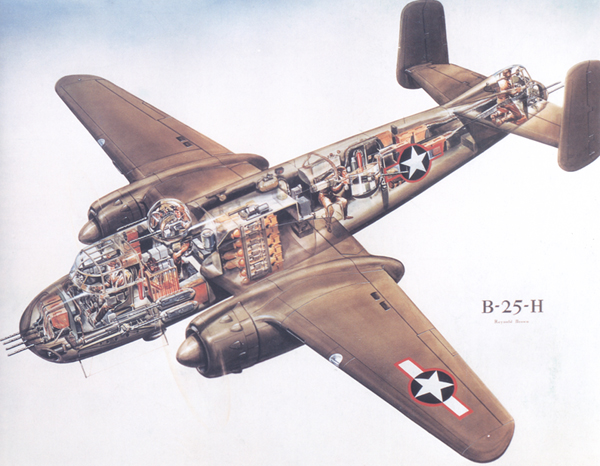

A more successful 75mm cannon-equipped B-25, the "H" variant carried fourteen (14!) machine guns and a lighter-weight 75mm cannon.
Room for all this hardware was made, in part, by deleting the co-pilot's position. The picture shows the position of the machine guns:

|
Four machine guns across the middle of the nose. The 75mm cannon is partially hidden in a 'well' low in the nose. Four machine guns in side 'blisters' (only port-side pair visible). Two in top 'dorsal' turret. Two in waist positions (again only port-side shown). Two in tail turret. |
![]()
|
On April 18, 1942, sixteen B-25B's leapt off the storm-swept decks of the carrier Hornet, 700 miles from their targets on the Japanese Home Islands. Still reeling from the devastating blow at Pearl Harbor four months earlier, Navy Captain Francis Low had hatched the plan to launch the USAAF twin-engine medium bombers at sea and have them land in China. Army Lt. Col. Jimmy Doolittle signed on to lead the raid. They determined that medium bombers could take off from aircraft carriers (just barely), but they could never land on them. Thus the planned landings at airfields in China. Doolittle recruited volunteers. (ed. I don;t know if any of the volunteer fliers were handsome P-40 fighter pilots who had been at Pearl Harbor, as presented in that movie.) On February 3, 1942, they successfully test-launched B-25's from Hornet. To prepare the planes for the mission, they overloaded them with 1141 gallons of gasoline, removed the ventral turrets (more on that later), and stuck black-painted broomsticks in the tail as dummy guns (okay, they got that detail right in the film). On April 2, with 16 Mitchells on board, Hornet steamed from San Francisco, heading for a launch point in the North Pacific, 400 miles from Tokyo. But they met Japanese picket boats well outside of that range, and felt compelled to launch. Strictly speaking, in a material sense, the raid inflicted some minor damage on four Japanese cities: Tokyo, Kobe, Yokohama, and Nagoya. All the bombers were lost; eleven crews bailed out, four crash-landed, one was interned in the Soviet Union. Most of the fliers who were downed in China eluded the Japanese, and made their way back to the States. But the raid's impact on Japanese morale and planning was incalculable. Among other effects, the raid immediately stilled any opposition to the proposed Midway attack amongst senior Japanese military planners. And the destruction of four Japanese carriers at that battle marked the end of Japanese advances in the Pacific. DevelopmentThe B-25 originated in a 1937 Army request for a twin-engine attack bomber that could out-perform existing single-engine types. Several companies submitted proposals; North American's NA-40 featured a crew of five, and narrow fuselage (made possible by unusual tandem seating of the pilot & co-pilot), shoulder-mounted wings, two Pratt & Whitney R-1830 radial engines, and provision for up to seven .30 caliber machine guns. (which grew to fourteen .50 calibers during the development of the B-25). The NA-40 didn't fly as fast as desired, so more powerful, 1600 hp Wright Cyclone R-2600 engines were installed in the next prototype, resulting in a top speed of 287 MPH. This prototype, the NA-40B crashed in April, 1939, and the Army selected the Douglas A-20 for the original attack bomber contract. But another requirement, put out in March of 1939, proved to fit North American's ideas. For this contract, they built the NA-62, a somewhat larger version, with a noticeably wider fuselage and side-by-side seating for the pilot & copilot. This aircraft won the competition for the 1939 medium bomber contract, and the Army ordered 184 planes, designated B-25; the first example accepted by the Army in February, 1941. Lee Atwood, a North American's chief engineer, suggested naming the B-25 for Billy Mitchell, which the Air Corps agreed to. Personally, I find it ironic that Billy Mitchell, the advocate of heavy bombers, was honored by an attack bomber - an aircraft type that, in many ways, was anathema to his concept of air power.
|
|
|
Die letzte gebaute Ausführung der Mitchell war die BL25J - von den etwa 10 000 gebauten Maschinen waren 4000 von der J-Ausführung. Einige dieser Maschinen wurden im Einsatz umgebaut und mit einer robusten Rumpfspitze mit acht Maschinengewehren versehen, was die Gesamtzahl auf achtzehn erhöhte. „Lady Luck“, der B-25J-Bomber, wurde in Süditalien vom 489. Squadron der 340. Bombardment Group eingesetzt. Die modifizierte J-Ausführung gehörte auch zu diesem Geschwader, dessen Flugzeuge größtenteils auf ihrem Flughafen zerstört wurden, als der Vesuv am 18. März 1944 ausbrach.
Mein
"Lady Luck " B-25 J
B-25J 4,318 B-25J's were built (all at Kansas City between Dec. 1943 and Aug. 1945), the largest production run of any B-25 version. No more cannons, but with eighteen machine guns (as many 'J's were modified) it was a formidable strafer. Bomb Groups in the Mediterranean and the Pacific received their first B-25J's in mid to late 1944.
North American B-25J Specs:
PBJ-1 - The Navy's B-25 In a complex, inter-service deal, the Navy (and Marine Corps) got some B-24 Liberators and B-25 Mitchells for patrol and anti-sub work. 706 Mitchells were assigned for use by the naval services; almost all of the PBJ-1's were flown by Marine Bomb Squadrons. Beginning in March 1944, seven of these VMS squadrons operated in teh Philippines, Saipa, Iwo Jima, and Okinawa. Post-War Service A few countries, notably China, France, Indonesia, and Brazil, operated Mitchells after the war. Unlike some WW2 types (P-51's and DC-3's), they did not see lengthy service anywhere, and were largely retired by the early 1950's. Some also served in the U.S. Air National Guard. North American converted a number to civilain uses - executive transports and fire-fighting aerial tankers.
|